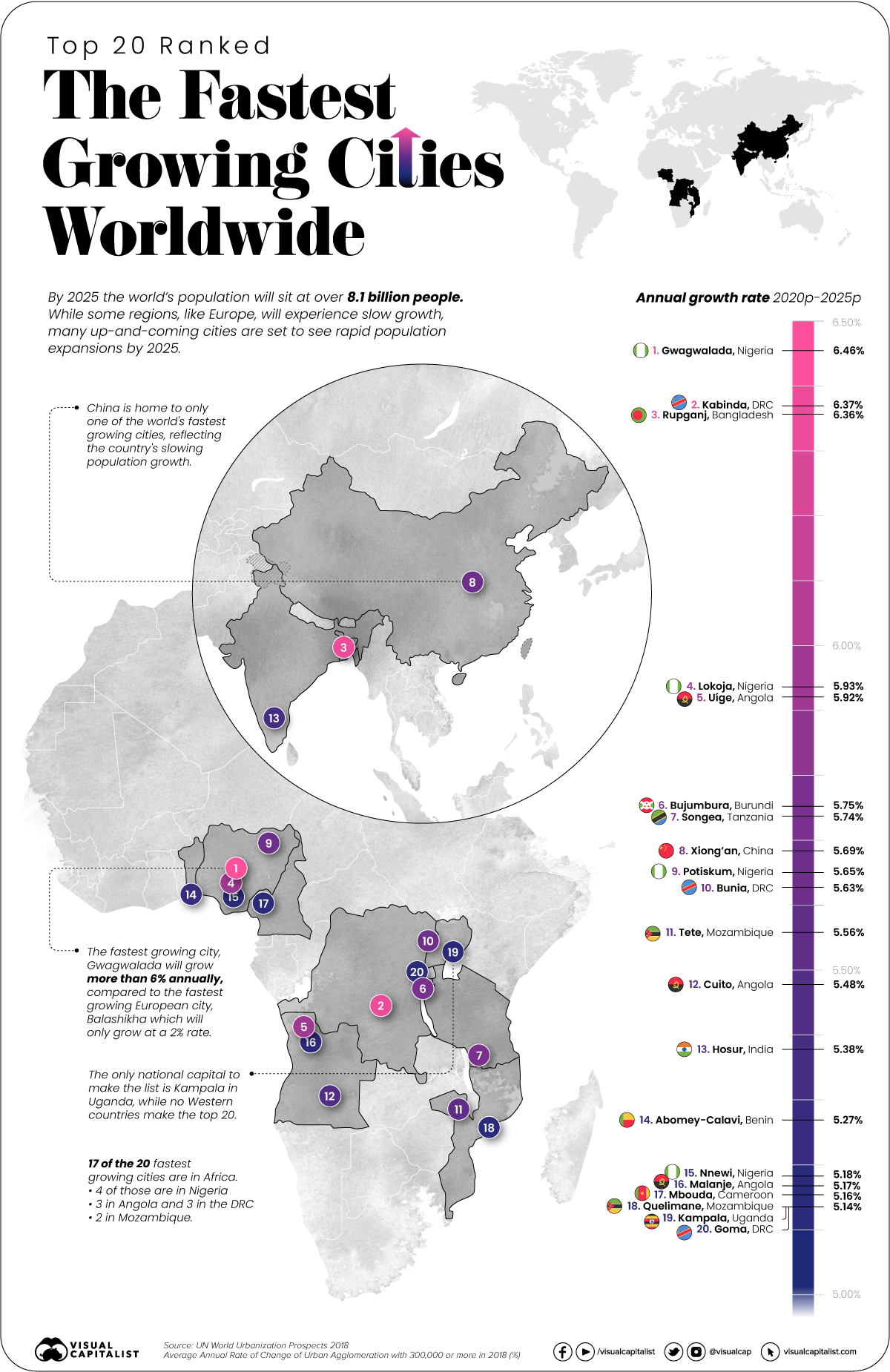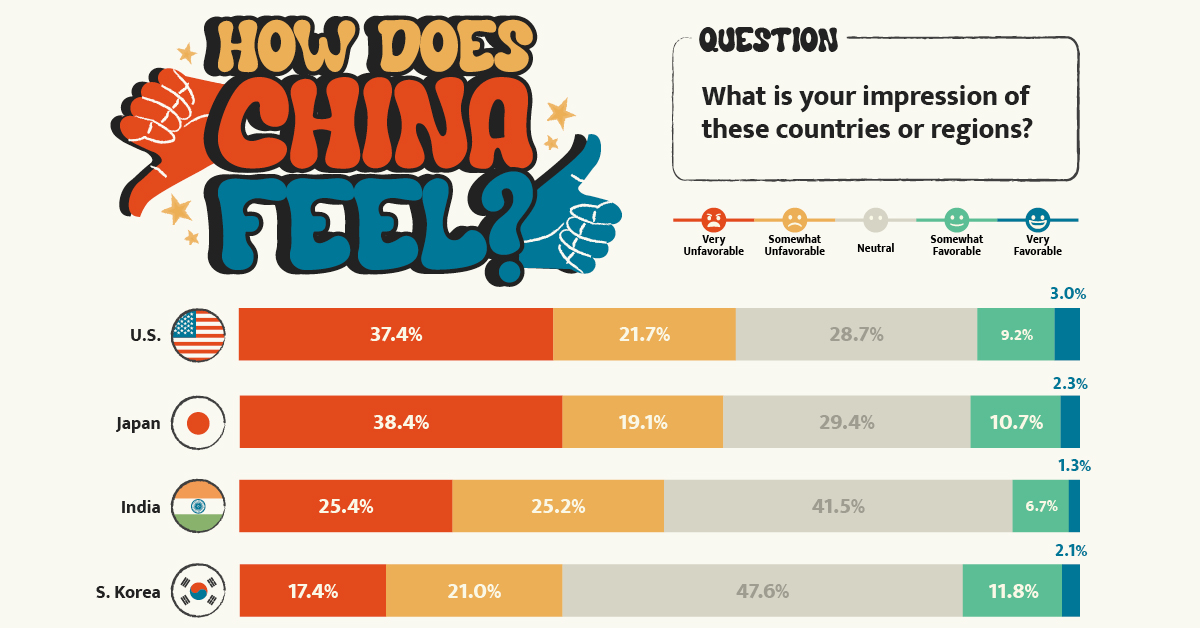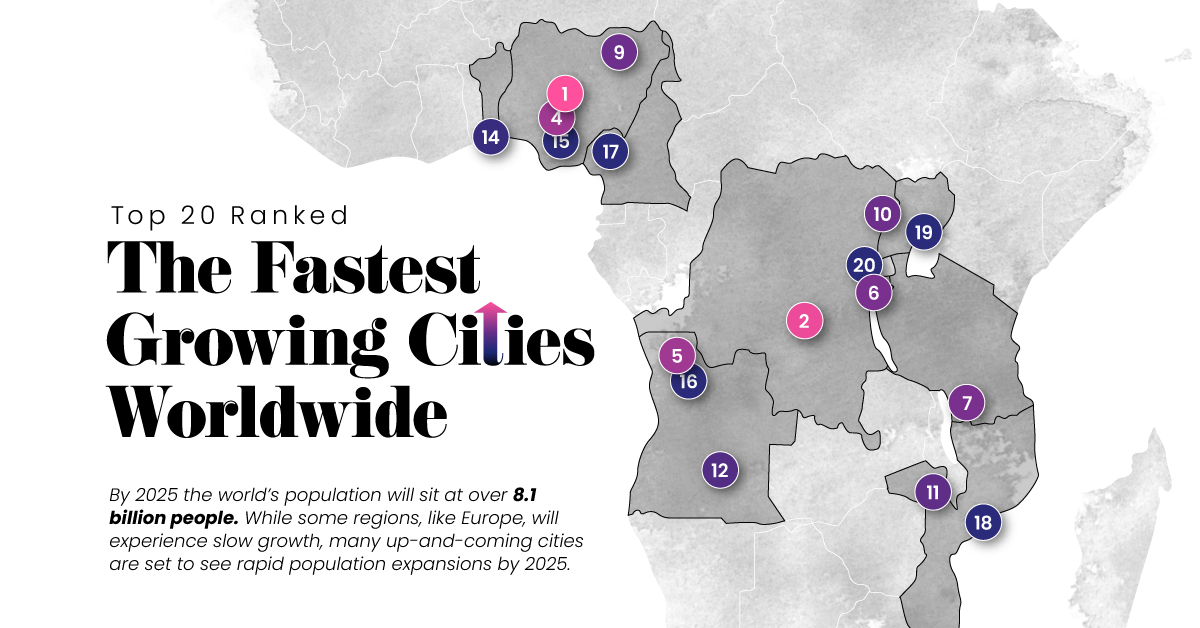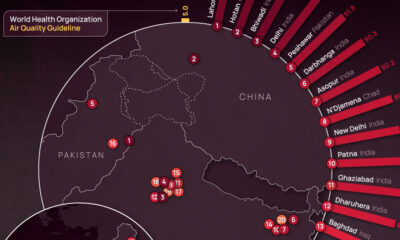Economy
Ranked: The World’s Fastest Growing Cities

Ranked: The World’s Fastest Growing Cities
By 2025, the world’s population will reach over 8.1 billion people.
Most of that population growth will be concentrated in cities across Africa and Asia. To help paint a detailed picture, this map uses data from the United Nations to rank the top 20 fastest growing cities in the world in terms of average annual growth rate from 2020 to 2025.
Full Speed Ahead
The majority of the world’s fastest growing cities are located in Africa—in fact, 17 of the 20 are located on the continent, with four of the 20 cities being located in Nigeria specifically.
Population growth is booming across the entire continent, as many countries retain high birth rates. According to the World Bank, the 2019 fertility rate (births per woman) in Sub-Saharan Africa was 4.6, compared to the global fertility rate of 2.4.
| City | Country | Continent | Annual Growth (2020-2025p) |
|---|---|---|---|
| Gwagwalada | 🇳🇬 Nigeria | Africa | 6.46% |
| Kabinda | 🇨🇩 Democratic Republic of Congo | Africa | 6.37% |
| Rupganj | 🇧🇩 Bangladesh | Asia | 6.36% |
| Lokoja | 🇳🇬 Nigeria | Africa | 5.93% |
| Uige | 🇦🇴 Angola | Africa | 5.92% |
| Bujumbura | 🇧🇮 Burundi | Africa | 5.75% |
| Songea | 🇹🇿 Tanzania | Africa | 5.74% |
| Xiongan | 🇨🇳 China | Asia | 5.69% |
| Potiskum | 🇳🇬 Nigeria | Africa | 5.65% |
| Bunia | 🇨🇩 Democratic Republic of Congo | Africa | 5.63% |
| Tete | 🇲🇿 Mozambique | Africa | 5.56% |
| Cuito | 🇦🇴 Angola | Africa | 5.48% |
| Hosur | 🇮🇳 India | Asia | 5.38% |
| Abomey-Calavi | 🇧🇯 Benin | Africa | 5.27% |
| Nnewi | 🇳🇬 Nigeria | Africa | 5.18% |
| Malanje | 🇦🇴 Angola | Africa | 5.17% |
| Mbouda | 🇨🇲 Cameroon | Africa | 5.16% |
| Quelimane | 🇲🇿 Mozambique | Africa | 5.14% |
| Kampala | 🇺🇬 Uganda | Africa | 5.14% |
| Goma | 🇨🇩 Democratic Republic of Congo | Africa | 5.14% |
Nigeria’s economy is largely based on petroleum which has resulted in the country becoming one of the strongest economies in Africa. This, coupled with a high birth rate and a resulting young population, has given the country a strong and rising workforce.
However, the population growth in Nigeria is both a blessing and a curse. The success of the economy, among other factors, has resulted in excessive rural-to-urban migration. This mass exodus from rural areas has led to less farming, which means the country now needs to import basic food staples at a high cost.
In Mozambique, Tete and Quelimane are growing 5.56% and 5.14% respectively. The country is expected to experience strong economic growth after facing contractions due to the pandemic. Forecasts predict that the Mozambiques’s economy will grow 4% by 2022.
Implications of Fast Growth
All of the top 20 fastest growing cities are located in either Africa or Asia, and they are far outpacing growth on other continents, such as Europe, for example.
Fastest Growing Cities: Europe vs. Global
| Europe's Fastest Growing Cities | Growth Rate | World's Fastest Growing Cities | Growth Rate |
|---|---|---|---|
| 🇷🇺 Balashikha, Russia | 2.01% | 🇳🇬 Gwagwalada | 6.46% |
| 🇷🇺 Tyumen, Russia | 1.88% | 🇨🇩 Kabinda | 6.37% |
| 🇦🇱 Tiranë (Tirana), Albania | 1.63% | 🇧🇩 Rupganj | 6.36% |
| 🇳🇴 Oslo, Norway | 1.38% | 🇳🇬 Lokoja | 5.93% |
| 🇷🇺 Sochi, Russia | 1.33% | 🇦🇴 Uige | 5.92% |
| 🇬🇧 Coventry-Bedworth, UK | 1.32% | 🇧🇮 Bujumbura | 5.75% |
| 🇸🇪 Stockholm, Sweden | 1.25% | 🇹🇿 Songea | 5.74% |
| 🇨🇭 Lausanne, Switzerland | 1.23% | 🇨🇳 Xiongan | 5.69% |
| 🇷🇺 Krasnodar, Russia | 1.22% | 🇳🇬 Potiskum | 5.65% |
| 🇷🇺 Surgut, Russia | 1.17% | 🇨🇩 Bunia | 5.63% |
| 🇷🇺 Podolsk, Russia | 1.16% | 🇲🇿 Tete | 5.56% |
| 🇮🇪 Dublin, Ireland | 1.12% | 🇦🇴 Cuito | 5.48% |
| 🇬🇧 London, UK | 1.12% | 🇮🇳 Hosur | 5.38% |
| 🇳🇱 Utrecht, Netherlands | 1.11% | 🇧🇯 Abomey-Calavi | 5.27% |
| 🇸🇪 Göteborg, Sweden | 1.07% | 🇳🇬 Nnewi | 5.18% |
| 🇫🇷 Toulouse, France | 1.07% | 🇦🇴 Malanje | 5.17% |
| 🇸🇪 Malmö, Sweden | 1.05% | 🇨🇲 Mbouda | 5.16% |
| 🇫🇷 Montpellier, France | 1.04% | 🇲🇿 Quelimane | 5.14% |
| 🇫🇷 Bordeaux, France | 0.99% | 🇺🇬 Kampala | 5.14% |
| 🇨🇭 Genève, Switzerland | 0.99% | 🇨🇩 Goma | 5.14% |
By 2050, Sub-Saharan Africa will be home to close to 2 billion people and roughly half will be under the age of 25. This represents an enormous labor force and opportunities for innovation and growth. In fact, in navigating the pandemic, Africa is already starting to capitalize on digital advances in both traditional and new sectors.
China has its eye on Africa, as evidenced through their multiple investments in infrastructure projects in the continent. Additionally, NATO countries have recently committed to investing similar amounts in Africa to counter China’s influence.
In spite of the economic potential, increased city sizes could be problematic for some of these countries. They will need to adapt to the issues associated with mass urbanization, like pollution, overcrowding, and high costs of living.
Changing Tides
Population booms can lead to massive economic growth, a larger (and younger) working population, and a growing domestic consumer market.
As the aforementioned cities continue their rapid expansion, and as people continue to flock to growing megacities in Africa and Asia, it could represent the beginning of an important economic shift that is worth keeping an eye on.
Politics
How Do Chinese Citizens Feel About Other Countries?
What is the Chinese public’s view of world powers? This visual breaks down Chinese sentiment towards other countries.

Public Opinion: How Chinese Citizens Feel About Other Countries
Tensions over Taiwan, the COVID-19 pandemic, trade, and the war in Ukraine have impacted Chinese sentiment towards other countries.
This visualization uses data from the Center for International Security and Strategy (CISS) at Tsinghua University to rank survey responses from the Chinese public on their attitudes towards countries and regions around the world.
Chinese Sentiment Towards Other Countries in 2023
In the Center’s opinion polls, which surveyed a random sample of more than 2,500 Chinese mainland adults in November 2022, Russia came out significantly ahead.
Just under 60% of respondents held Russia in a favorable view, with 19% seeing the country as “very favorable.” Contrast that to the mere 12% that viewed the U.S. in a positive light.
Here’s a closer look at the data. The percentages refer to the share of respondents that voted for said category.
| Country/Region | Very Unfavorable | Somewhat Unfavorable | Neutral | Somewhat Favorable | Very Favorable |
|---|---|---|---|---|---|
| 🇺🇸 United States | 37.4% | 21.7% | 28.7% | 9.2% | 3.0% |
| 🇯🇵 Japan | 38.4% | 19.1% | 29.4% | 10.7% | 2.3% |
| 🇮🇳 India | 25.4% | 25.2% | 41.5% | 6.7% | 1.3% |
| 🇰🇷 South Korea | 17.4% | 21.0% | 47.6% | 11.8% | 2.1% |
| 🇪🇺 European Union | 9.3% | 15.6% | 57.6% | 14.1% | 3.3% |
| Southeast Asia | 7.1% | 13.1% | 59.5% | 16.8% | 3.5% |
| 🇷🇺 Russia | 3.0% | 4.8% | 33.7% | 39.4% | 19.0% |
Japan ranked just below the U.S. in terms of overall unfavorability, though a slightly higher share of respondents saw Japan as “very unfavorable” compared to America. This is likely due to both modern tensions in the East China Sea over mutually claimed islands and historical tensions over the Sino-Japanese Wars.
Chinese sentiment towards India was also unfavorable at just over 50%, though notably the country also received the lowest favorability rating at just 8%.
Additional Survey Findings
The survey also found that 39% of Chinese people get their information on international security from Chinese state-run media (mainly through TV), with an additional 19% getting information from government websites and official social accounts. Conversely, only 1.7% get their news from foreign websites and foreign social media, partially due to the Great Firewall.
When asked about different international security issues, the biggest shares of Chinese citizens ranked the following as their top three:
- Pandemics (12.9%)
- Disputes over territory and territorial waters (12.9%)
- China-U.S. relations (12.0%)
The pandemic’s high score reflects the harsher impact COVID-19 had on China. Chinese borders were shut for years and the public faced intense measures to reduce spread.
In terms of other world events, the majority of Chinese people align with a more “Eastern” viewpoint. For example, in regards to the war in Ukraine, the report found that:
“About 80 percent of the respondents believe the U.S. and Western countries should be held most accountable [for the war], while less than ten percent of the respondents argue that Russia is mainly responsible.”– Center for International Security and Strategy, Tsinghua University
Overall, the views of the Chinese public reflect the opposite of those found in many Western countries. They provide an important insight that it is not just the Chinese government holding particular views about the world, but the Chinese public as well.
-

 Environment5 days ago
Environment5 days agoHotter Than Ever: 2023 Sets New Global Temperature Records
-

 Datastream4 weeks ago
Datastream4 weeks agoCan You Calculate Your Daily Carbon Footprint?
-

 Energy2 weeks ago
Energy2 weeks agoWho’s Still Buying Russian Fossil Fuels in 2023?
-

 VC+4 days ago
VC+4 days agoWhat’s New on VC+ in July
-

 Investor Education4 weeks ago
Investor Education4 weeks agoVisualizing BlackRock’s Top Equity Holdings
-

 apps2 weeks ago
apps2 weeks agoMeet the Competing Apps Battling for Twitter’s Market Share
-

 Politics14 hours ago
Politics14 hours agoHow Do Chinese Citizens Feel About Other Countries?
-

 Markets4 weeks ago
Markets4 weeks agoVisualizing Every Company on the S&P 500 Index













